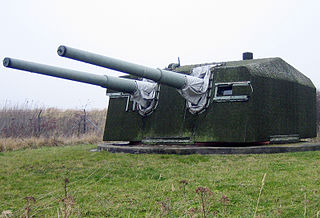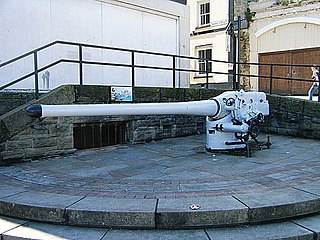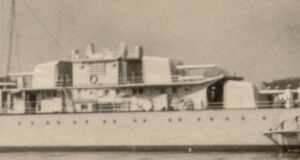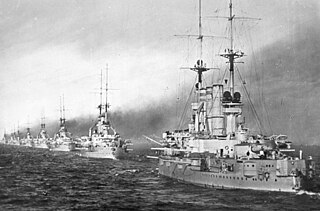
The 24 cm SK L/40 "Theodor Karl" was a German railroad gun that served on both the Eastern Front and the Western Front in World War I. Originally a naval gun, it was adapted for land service after its ships were disarmed beginning in 1915. One gun saw service in the Belgian Army after the war. After Belgium's surrender in World War II, the Germans used that gun on coast-defense duties for the rest of the war.

The 38 cm Siegfried K (E) was a German World War II railway gun based on the 38 cm SK C/34 naval gun that served as the main armament of the Bismarck-class battleships. Only four were produced.

The 15 cm SK C/28 was a German medium-caliber naval gun used during the Second World War. It served as the secondary armament for the Bismarck class and Scharnhorst-class battleships, Deutschland-class cruisers and the Graf Zeppelin-class aircraft carriers. A number of surplus weapons were used as coast-defense guns and eight were adapted to use Army carriages and used as heavy field guns as the 15 cm Schiffskanone C/28 in Mörserlafette

The 15 cm SK C/25 was a German medium-caliber naval gun used during the Second World War. It served as the primary armament for the K- and Leipzig-class cruiser. No surplus weapons of this type appear to have been used as coast-defense guns.

The 28 cm SK L/40 was a German naval gun that was used in World War I and World War II as the main armament of the Braunschweig- and Deutschland-class pre-dreadnoughts.

The 28 cm SK L/45 was a German naval gun that was used in World War I and World War II. Originally a naval gun, it was adapted for land service after World War I.

The 8.8 cm SK L/45 was a German naval gun that was used in World War I and World War II on a variety of mounts.

The 17 cm SK L/40 was a Kaiserliche Marine naval gun that was used on two classes of German pre-dreadnought battleships the Braunschweig-class and the Deutschland-class as their secondary battery. Later they were adapted for land service during World War I and World War II.
The 8.8 cm SK C/31 was a German naval gun that was used in World War II.
The 8.8 cm SK C/32 was a German naval gun that was used in World War II.

The 8.8 cm SK C/35 was a German naval gun used in World War II.

The 10.5 cm SK L/40 (SK - SchnelladekanoneL - Länge was a German naval gun used in World War I and World War II.

The 10.5 cm SK L/45 was a German naval gun that was used in World War I and World War II and was the successor of the older 10.5 cm SK L/40 naval gun.

The 15 cm SK L/40 was a German naval gun that was used as secondary armament on pre-dreadnought battleships, protected cruisers and armored cruisers of the Imperial German Navy in World War I. It was also used as a coast-defence gun during World War II.

The 8.8 cm SK L/30 (SK - SchnelladekanoneL - Länge was a German naval gun that was used in World War I on a variety of mounts.

The 12.7 cm SK C/34 was a German medium-caliber naval gun deployed on destroyers from 1934 through the Second World War. Some of these guns remained in service until 2003 in the coastal defense units of Norway.
The 5 cm SK L/40 gun was a German naval gun used in World War I and World War II.

The 5.28 cm SK L/55 was a German naval gun that was used before and during World War I on a variety of mounts, in torpedo boats and cruisers.

The 24 cm K L/35 was a German Naval Gun developed in the years before World War I that armed ships of the Imperial German Navy, Argentine Navy and the Austro-Hungarian Navy. Guns removed from ships of the Imperial German Navy were modified to perform Coastal Artillery and Railway Artillery roles and saw service in both world wars. The actual bore diameter was 23.8 cm (9.4 in), but the classification system for artillery rounded up to the next highest centimeter.
The 10.5 cm SK L/35 (SK - SchnelladekanoneL - Länge was a German naval gun developed in the years before World War I that armed a variety of warships of the Imperial German Navy during World War I. In addition to the Imperial German Navy the 10.5 cm SK L/35 was used by the Royal Netherlands Navy, Ottoman Navy and Spanish Navy.

OCLC Online Computer Library Center, Incorporated d/b/a OCLC is an American nonprofit cooperative organization "dedicated to the public purposes of furthering access to the world's information and reducing information costs". It was founded in 1967 as the Ohio College Library Center. OCLC and its member libraries cooperatively produce and maintain WorldCat, the largest online public access catalog (OPAC) in the world. OCLC is funded mainly by the fees that libraries have to pay for its services. OCLC also maintains the Dewey Decimal Classification system.

The International Standard Book Number (ISBN) is a numeric commercial book identifier which is intended to be unique. Publishers purchase ISBNs from an affiliate of the International ISBN Agency.

























